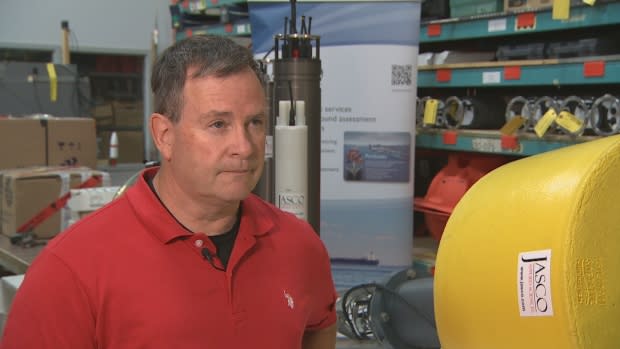Despite shallow labour pool, Nova Scotia's ocean tech sector is booming
The Burnside Industrial Park in Dartmouth, N.S., doesn't necessarily look like a place where inspiration lives, but a couple dozen companies are doing some pretty amazing things inside those faceless buildings.
They are part of Nova Scotia's growing ocean tech sector, which is quietly designing, building and selling products in Canada and around the world.
The cluster of companies is marked by double-digit growth and the development of a local supply chain that produces many of the sophisticated components that go into a long list of specialized products.
In a warehouse at JASCO Applied Sciences, engineering manager John Moloney looks over an observer buoy destined for Kitimat, B.C.
About two metres long, the brains of the buoy is a small cylindrical measuring and detection device.
It will be deployed for real-time monitoring of sound generated by pile-driving during construction of a liquefied natural gas terminal. That can help determine impact on marine life.
"Basically, everything you see other than the float itself, this piece of foam was either supplied by a local company, manufactured by a local company or produced or assembled by a local company," said Moloney.
22 local suppliers contribute to 1 product
JASCO used 22 Nova Scotia companies, many based in Burnside — to produce the Kitimat observer buoy. Electronics, pressure housing and connection cables were among the elements sourced locally.
Moloney said his company produces equipment for up to 30 projects per year and relies on the local supply chain each time.
"We're probably in the order of about a $10-million company," he said. The company has 45 employees.
He said the projects likely produce up to $6 million per year for local suppliers.
N.S. ocean tech 'on every continent, in every ocean'
Moloney said the industry's reach was on display recently at Woods Hole, Mass., home to one of the world's leading oceanographic research stations.
"I was looking at … a billion dollars of equipment sitting on their base shop floor waiting to go out the door and most of the sensor systems that were on those moorings came from Atlantic Canada, from Canadian companies," he said.
"This has international impact. We are doing projects all around the globe, on every continent, in every ocean."
Eighty per cent of Nova Scotia's ocean tech products are exported.

Techtronics Machine Works of Musquodoboit Harbour is one of the 22 suppliers used in JASCO's observer buoy project.
The company and a related business — Velocity Machining and Welding in Burnside — produce a variety of subsea instrumentation housings made of plastics, steel, titanium alloys and other materials. They are installed on cameras and remotely operated vehicles.
"For Techtronics, it's a big piece of our business," said co-owner Sean MacPhee. "We manufacture products that we don't ship all over the world, but they end up there through our customers in Nova Scotia."
Labour shortage a growing pain
The company's biggest challenge is a skilled labour shortage. MacPhee said Velocity is doubling its footprint to 20,000 square feet.
"The bottleneck is labour, has been for years," he said. "But it's much worse now than it's ever been."
Between Techtronics and Velocity, the two businesses have about 60 employees.
MacPhee wants the province's community college to produce more machinists, saying government knows the industry will need 400 machinists over the next decade, but only eight to 12 are graduating each year.
What is ocean tech exactly?
Statistics Canada does not measure ocean technology as a separate sector. The Nova Scotia government said it's made up of 80 core companies.
The sector primarily works for defence, oil and gas, fisheries, aquaculture and marine renewable energy companies.
The province said "ocean related" industries generate $4.5 billion — or 12.2 per cent of provincial GDP — but that does not break down how much is from the high-innovation ocean tech sector.
Employment numbers haven't been defined either.
Most ocean tech companies are small and medium-size businesses.
Why ocean tech is growing
What is clear is the sector is growing.
Paul Yeatman, chair of the Ocean Technology Council of Nova Scotia, said growth is being driven by defence, oil and gas, and stricter environmental monitoring rules.
On the defence side, the focus is on anti-submarine warfare.
In 2017, Canada set aside $133 million for research with a focus on sovereignty in the Arctic.

Canada's five year "all domain situational awareness" program includes monitoring subsurface and Maritime traffic in or approaching Canada's North.
Governments everywhere are also requiring more environmental monitoring, said Yeatman.
"The European Union, for example, put out an edict that everyone had to monitor their coastal waters," he said. "It's not a wishful thing, it's a must do. And so, they're monitoring. So, where are they going to get their equipment from? A lot of it's coming out of Nova Scotia."
An ocean hub
In his day job, Yeatman is president of GeoSpectrum Technologies, another Burnside-based acoustics specialist.
He said the firm is also flourishing and has a growth rate of 30 per cent per year, but is also struggling to find people.
Growing demand has prompted companies in the supply chain to co-operate to tackle big projects.
"We have some companies that are suppliers here that support us and we also supply to them," said Yeatman. "It depends on the project and the skill sets."
He said almost any product his company may require can be supplied locally.
"That's pretty impressive," said Yeatman.
MORE TOP STORIES


